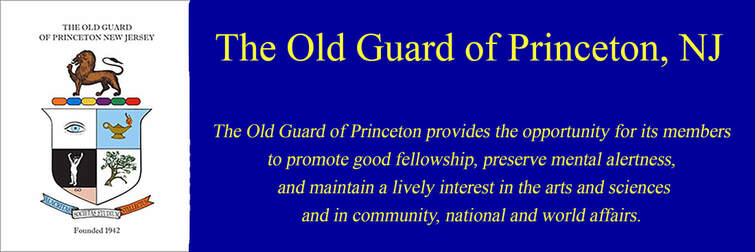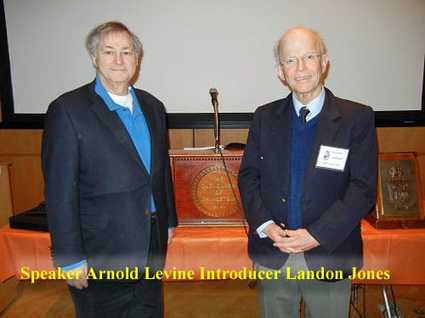January 18, 2012
The Benefits of the Human Genome Project
Arnold Levine
Professor, School of Natural Sciences,
Institute for Advanced Study
The Benefits of the Human Genome Project
Arnold Levine
Professor, School of Natural Sciences,
Institute for Advanced Study
Minutes of the 16th Meeting of the 70th Year
Robert Varrin called the 8th meeting of Old Guard’s 70th year to order at 10:15 hours on 18 January 2012 in the Friends Center. The invocation was led by Tom Fulmer and the 11 January minutes were read by John Schmidt.
The following guests were introduced: Joe Wisnovsky by Lanny Jones, John Van Raalte by Michael Kaplan, Cindy Clark by her husband Charles Clark, and Ted Bromley by Nick Wilson.
The Membership Chairman, Jack Reilly, introduced a new member, David Scott.
President Varriin announced-
“THE BENEFITS OF THE HUMAN GENOME PROJECT”
Professor Arnold Levine began his thoughts about “who we are as human beings --in the biological sense” by turning to ancient Greek philosophers who asked three questions.
Humans have 23 paired chromosomes. One part of the pair is from the female parent and the other from the male. With fertilization, 23 un-paired chromosomes from the female line up with the corresponding chromosomes from the male. Each chromosome is made up of long stretches of DNA.
A gene is any segment along the DNA that encodes instructions to make something. DNA is made up of four chemicals labeled C,G,A,and T. These four letters become the alphabet for all genes. Like the dot and dash two letter alphabet of Morse Code, the sequencing of C,G,A,T determines the function of a gene. Further the syntax of the first letters may determine a common action e.g. A,T,G means make a protein, which protein is determined by the subsequent sequence of C,G,A,T. One gene makes one protein.
If the fruit fly has a genome of 16,000 genes. How many genes do human’s have? Humans have approximately 30,000 genes, the first 16,000 of which are almost identical to the fruit fly’s 16,000. The function of many genes has been determined such as the production of insulin. Isolation of this gene and injection of it into bacteria causes the bacteria to produce insulin which is harvested and used in diabetics. But, 50% of our genes seem to have no function.
The bottom line is that all living things are related with a uniform unchangeable alphabet and language. Professor Levine posed the question, “with space travel, will we find the same alphabet for living things in other parts of the universe?”
Comparing the genomes of various life forms is called comparative genomics. Our genome is 95% related to a mouse and 99% related to a Chimp. The common ancestors with the mouse occurred 100 million years ago and the chimp 8 million years ago. The genome of 99.9% of all humans are identical. But because there are 3 billion letters in our genome, the 0.1 % means that 3 million places on the genome can be different. Such little variation in our genome indicates we are a relatively new species of living things, but that 0.1% variation , influenced by climate, ice ages, water and food availability allows us to map the migrations of man beginning with 10,000 hunter/ gatherers from southern Africa 170,000 years ago to the Middle East 100,000 years ago to Asia and Australia 80,000 years ago, to Europe 20,000 years ago and to the Americas 12,000 years ago. The populations remaining in Africa, Asia and Europe did not mix and were genetically altered influenced by their environment defining the three races of mankind.
An example of genetic selection based on diet is found in the Maisai people living in Kenya and Tanzania. Their daily high fat, high cholesterol 3,000 calorie diet of cow’s blood and milk is tolerated without the hypercholesterolemia effects other humans would experience. Comparative genetic studies identified a gene called FABP-1 or fatty acid binding protein gene -1. FABP-1 programs the Maisai’s digestive system to process large amounts of fat maintaining a normal blood cholesterol and consequently a normal cardiovascular system.
One great benefit of the Human Genome Project is the ability to map the multiple migrations of humans based on sequence variations of the genetic alphabet, CGAT. Decoding studies of 1000 year old human remains in Mongolia or distinctive genetic patterns of groups of people are re-constructing history and helping us to answer the question, where did we come from.
One reason the Project was undertaken was to understand cancer, especially to identify those who have a genetic predisposition to get cancer at a young age or are predisposed to get cancer from environmental exposure such as smoking. Dr Levine commented,” All diseases we have are caused by a combination of environment and genetics.”
In conclusion, Dr Levine feels the 3 billion dollars invested between 1999 and 2001 are starting to pay off. In 5 to 10 years, he predicts a medical visit will include blood drawn to sequence a patient’s genome for $1,000 the results of which will be ready in 2 hours, stored in a digital medical record and guide a plan of action tailored to the individual patient. “ This is the beginning of a change in medical practice and the way drugs are made.”
An active question period followed and the meeting was closed at 11:30.
Respectfully submitted,
George H Hansen
The following guests were introduced: Joe Wisnovsky by Lanny Jones, John Van Raalte by Michael Kaplan, Cindy Clark by her husband Charles Clark, and Ted Bromley by Nick Wilson.
The Membership Chairman, Jack Reilly, introduced a new member, David Scott.
President Varriin announced-
- The Program Committee is to meet at 9AM on January 25 in the Dean’s conference room.
- Old Guard ties and scarves were available for purchase from Treasurer Guy Dean.
- That recently, a long term member gave an Old Guard document from the past to our Historian, Jim Ferry, to be added to the collection of our memorabilia housed by the Princeton Historical Society. The President invited members to contribute similar documents capturing the history of this fine organization.
- The next meeting’s speaker is Professor John Fleming. The title of his talk is “The King James Bible and More.”
“THE BENEFITS OF THE HUMAN GENOME PROJECT”
Professor Arnold Levine began his thoughts about “who we are as human beings --in the biological sense” by turning to ancient Greek philosophers who asked three questions.
- Who are we?
- Where did we come from?
- And Why are we here?
Humans have 23 paired chromosomes. One part of the pair is from the female parent and the other from the male. With fertilization, 23 un-paired chromosomes from the female line up with the corresponding chromosomes from the male. Each chromosome is made up of long stretches of DNA.
A gene is any segment along the DNA that encodes instructions to make something. DNA is made up of four chemicals labeled C,G,A,and T. These four letters become the alphabet for all genes. Like the dot and dash two letter alphabet of Morse Code, the sequencing of C,G,A,T determines the function of a gene. Further the syntax of the first letters may determine a common action e.g. A,T,G means make a protein, which protein is determined by the subsequent sequence of C,G,A,T. One gene makes one protein.
If the fruit fly has a genome of 16,000 genes. How many genes do human’s have? Humans have approximately 30,000 genes, the first 16,000 of which are almost identical to the fruit fly’s 16,000. The function of many genes has been determined such as the production of insulin. Isolation of this gene and injection of it into bacteria causes the bacteria to produce insulin which is harvested and used in diabetics. But, 50% of our genes seem to have no function.
The bottom line is that all living things are related with a uniform unchangeable alphabet and language. Professor Levine posed the question, “with space travel, will we find the same alphabet for living things in other parts of the universe?”
Comparing the genomes of various life forms is called comparative genomics. Our genome is 95% related to a mouse and 99% related to a Chimp. The common ancestors with the mouse occurred 100 million years ago and the chimp 8 million years ago. The genome of 99.9% of all humans are identical. But because there are 3 billion letters in our genome, the 0.1 % means that 3 million places on the genome can be different. Such little variation in our genome indicates we are a relatively new species of living things, but that 0.1% variation , influenced by climate, ice ages, water and food availability allows us to map the migrations of man beginning with 10,000 hunter/ gatherers from southern Africa 170,000 years ago to the Middle East 100,000 years ago to Asia and Australia 80,000 years ago, to Europe 20,000 years ago and to the Americas 12,000 years ago. The populations remaining in Africa, Asia and Europe did not mix and were genetically altered influenced by their environment defining the three races of mankind.
An example of genetic selection based on diet is found in the Maisai people living in Kenya and Tanzania. Their daily high fat, high cholesterol 3,000 calorie diet of cow’s blood and milk is tolerated without the hypercholesterolemia effects other humans would experience. Comparative genetic studies identified a gene called FABP-1 or fatty acid binding protein gene -1. FABP-1 programs the Maisai’s digestive system to process large amounts of fat maintaining a normal blood cholesterol and consequently a normal cardiovascular system.
One great benefit of the Human Genome Project is the ability to map the multiple migrations of humans based on sequence variations of the genetic alphabet, CGAT. Decoding studies of 1000 year old human remains in Mongolia or distinctive genetic patterns of groups of people are re-constructing history and helping us to answer the question, where did we come from.
One reason the Project was undertaken was to understand cancer, especially to identify those who have a genetic predisposition to get cancer at a young age or are predisposed to get cancer from environmental exposure such as smoking. Dr Levine commented,” All diseases we have are caused by a combination of environment and genetics.”
In conclusion, Dr Levine feels the 3 billion dollars invested between 1999 and 2001 are starting to pay off. In 5 to 10 years, he predicts a medical visit will include blood drawn to sequence a patient’s genome for $1,000 the results of which will be ready in 2 hours, stored in a digital medical record and guide a plan of action tailored to the individual patient. “ This is the beginning of a change in medical practice and the way drugs are made.”
An active question period followed and the meeting was closed at 11:30.
Respectfully submitted,
George H Hansen

